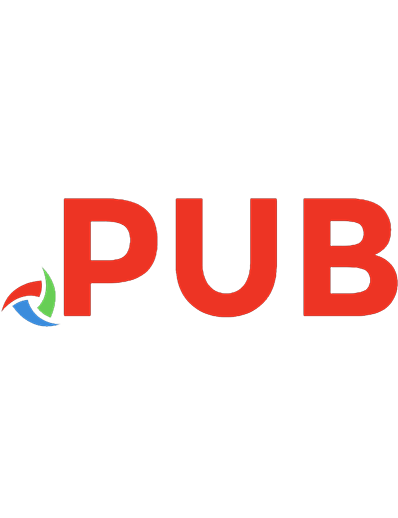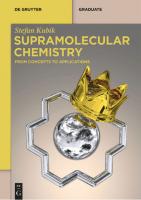Copper Bioinorganic Chemistry: From Health to Bioinspired Catalysis 9789811269486
Bioinorganic chemistry is an interdisciplinary research field which centers on metals in biology. Over the past few deca
136 19 9MB
English Pages 270 [271] Year 2023
Table of contents :
Cover
Half Title
Copper Bioinorganic Chemistry: From Health to Bioinspired Catalysis
Copyright
Preface
References
Contents
1. Ligands as a Tool to Tune the Toxicity of Cu on Bacteria: from Boosting to Silencing
I. Introduction
II. Copper, a Biocidal Compound
III. Copper Homeostasis Systems in Bacteria
IV. Copper Toxicity: A Phenomenon Dependent on the Bioavailability of Copper and on Bacteria
V. Specificity of Copper Chemistry
A. Cu Coordination Chemistry
B. Cu Reactivity: The Case of ROS Production
C. In Vivo Complexation of Cu
VI. Mechanisms of Cu Toxicity: Macromolecules Targeted by Copper
A. Membranes
B. DNA
C. Proteins
VII. Chemistry of Copper Complexes
A. Reactivity of Cu Complexes
B. Stability of the Cu-L Complex
C. Kinetics of the Cu-L Complex
D. Redox Potential
VIII. Impact of Ligands on the Biological Activity of Copper
A. Localization
B. Presence in Biology of Potentially Competing Ligands for Cu(II)
C. Presence in Biology of Potentially Competing Ligands for Cu(I)
D. Reactivity of Cu-L in Bacteria
E. Reactivity of the Free Ligand in Bacteria
IX. Copper Complexes as Antimicrobial Agents, a Non-Exhaustive List
A. Dithiocarbamates Compounds
B. 8-Hydroxychinoline (8-HQ) Compounds
C. Phenanthrolines
D. Pyrithione
E. Bis-Thiosemicarbazones (atsm, gtsm)
X. Peptides-Based Cu-Chelators
XI. Recent Advances Toward the Future Use of Copper in Medicine
XII. References
2. Transition State Analogue Molecules as Mechanistic Tools and Inhibitors for Tyrosinase
I. Introduction
II. Biological Functions of Melanins
A. Melanin as Color Pigment
B. Melanin as a Defensive Barrier
III. Tyrosinase
A. Structures of the Tyrosinase Active Sites
B. Catalytic Mechanism of Tyrosinase
C. Tyrosinase-Related Proteins TRP1 and TRP2
IV. Dysfunction in Tyrosinase Activity
A. Pathologies Linked to TYR Dysfunction
B. Skin Whitening
V. Tyrosinase Inhibition
A. Variation in TYR Sources
B. Transition-State Analogue (TSA) Inhibitors
1. L-Mimosine
2. Kojic acid and derivatives
3. Tropolone and derivatives
4. HOPNO inhibitor
5. HOPNO derivatives
VI. Conclusions
Acknowledgment
VII. References
3. Modeling Tyrosinase Activity Using m-Xylyl-Based Ligands: Ring Hydroxylation, Reactivity, and Theoretical Investigation
I. Introduction
A. General Considerations
B. Scope of the Review
II. Dicopper Proteins — Brief Overview
A. Hemocyanins
B. Tyrosinases
C. Catechol Oxidase
III. Three Cu2O2 Core Structures
IV. Biomimetic Studies on Tyrosinase
A. Intramolecular m-Xylyl and Aromatic Ring Hydroxylation
B. Intramolecular m-Xylyl and Aromatic Ring Hydroxylation
C. Ring Hydroxylation Reactions with Non-m-Xylyl-Based Ligands
D. Oxidation of External Substrates by Dicopper Systems
V. Theoretical Studies on Tyrosinase Models
A. Frontier Molecular Orbitals of the Cu2O2 Cores
1. μ-η2:η2-Peroxo-dicopper(II): {CuII2(μ-η2:η2 O2)}2+{Cu2PS}
2. Trans-μ-1,2-peroxo-dicopper(II): {CuII2(μ-η1:η1-O2)}2+ {Cu2PE}
3. Bis(μ-oxido)dicopper(III): {CuIII2(μ-O)2}2+ {Cu2O2}
B. Interconversion Between {Cu2PS} and {Cu2O2} Cores: A Torture Track for Computations
C. {Cu2PS}, {Cu2PE}, and {Cu2O2} Motifs in C−H Oxidation: DFT Studies
1. Aromatic C−H hydroxylation via {Cu2PS} motifs
2. Aromatic C−H hydroxylation via {Cu2O2}
3. Aromatic C−H hydroxylation via {Cu2PE}
VI. Conclusions
VII. References
4. Monooxygenation of Phenols by Small-molecule Models of Tyrosinase: Correlations Between Structure and Catalytic Activity
I. Introduction
II. Model Systems of Tyrosinase
A. Model Systems Performing Ligand Hydroxylation
B. Model Systems Exhibiting Reactivity Toward External Substrates
III. Catalytic Tyrosinase Models with Bidentate Ligands
A. Mechanistic Cycle of the Tyrosinase-like Monooxygenation of External Substrates
B. Substitution of Pyridine in the Lpy1 Ligand by N-Heterocycles
C. Substitution of Imine in the Lpy1 Ligand by N-heterocycles: Symmetric Bidentate Ligands
D. Hybrid Ligands Composed of Different N-Heterocycles
E. Steric Influence of Substituents on the Supporting Ligands
F. Variation of Substrates: Electronic and Steric Factors
IV. Summary
V. Acknowledgment
VI. References
5. Electrochemistry and Spectroelectrochemistry of Copper-Oxygen-Relevant Species
I. Introduction
II. Electrochemistry of Peroxide and Superoxide Copper–Oxygen Species
III. Electrochemistry of Copper(II) Hydroxo, Alkoxo, Carboxylato, and Oxo Precusors
IV. Electrochemistry of Copper Hydroperoxide and Alkoxoperoxide Species
V. Electrochemistry of Copper(II)-Phenoxide Species
VI. Electrochemistry of Nitroso and Sulfide Analogues of Copper–Oxygen Complexes
VII. Summary
VIII. References
6. Inorganic Models of Lytic Polysaccharide Monooxygenases
I. Introduction
II. Lytic Polysaccharide Monooxygenases
III. Copper Complexes as Hydrolase Mimics
A. Polysaccharide Hydrolysis
B. Copper Complexes
IV. Copper Complexes as LPMO Mimics
A. Copper(II)/Bis(Benzimidazolyl)Amine System
B. Copper(III)/Bis(Carboxamido)Pyridine System
C. Copper(II)/Copper(I)/(Pyridyl,Imidazolyl)Amine System
D. Copper(II)/(Pyridyl)Diazepane Complexes
E. Copper(II)/Bis(Imidazolyl)Amine System
F. Copper(II)/Bis(Picolyl)Amine System
V. Concluding Remarks
VI. References
7. Structure and Function of Cu–Peptoid Complexes
I. Introduction
A. Peptoid Synthesis
B. Secondary Structure of Peptoid Oligomers
II. Structural Aspects of Cu(II)–Peptoid Complexes
A. Structural Design of Cu(II)–Peptoid Complexes
B. Choice of the Metal-Binding Ligands
C. Characterization of Cu(II)–Peptoid Complexes
1. Evaluation of Cu(II) binding and synthesis of Cu(II)–peptoid complexes
2. Determining the association constants and evaluating the selectivity of the peptoid chelators to Cu(II)
3. Structure and coordination sphere of Cu centers within Cu(II)–peptoid complexes
III. Effect of Cu(II) Binding on the Structure of Peptoid
A. Cu(II) Binding as a New Approach for Peptoid Folding
B. Cu(II)-Mediated Peptoids Self-Assembly
IV. From Structure to Function: Cu-Binding Peptoids and Cu–Peptoids as Functional Materials
A. Selective Recognition of Small Molecules by Self-Assembled Cu(II)–Peptoids
B. Selective Recognition of Cu(II) by Peptoids Toward Drug Design
C. Positive Allosteric Cooperativity in Metal Binding to Cu(II)–Peptoid
D. Cu(II)–Peptoid Complexes as Versatile, Efficient, and Selective Bio-Inspired Catalysts
V. Summary
VI. References
Index


![Comprehensive Inorganic Chemistry III. Volume 2: Bioinorganic Chemistry and Homogeneous Biomimetic Inorganic Catalysis [3 ed.]
9780128231449](https://dokumen.pub/img/200x200/comprehensive-inorganic-chemistry-iii-volume-2-bioinorganic-chemistry-and-homogeneous-biomimetic-inorganic-catalysis-3nbsped-9780128231449.jpg)







